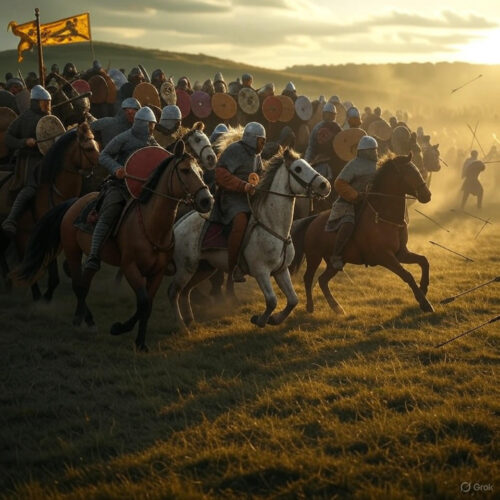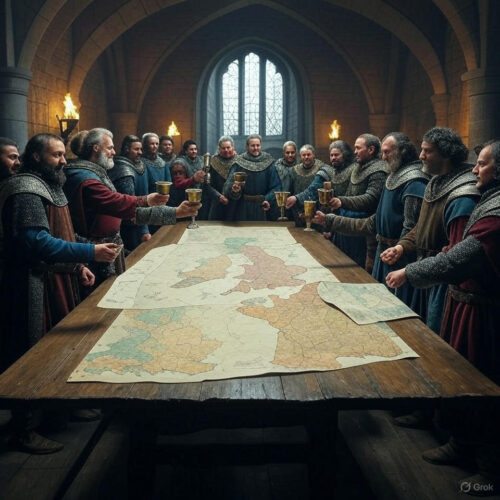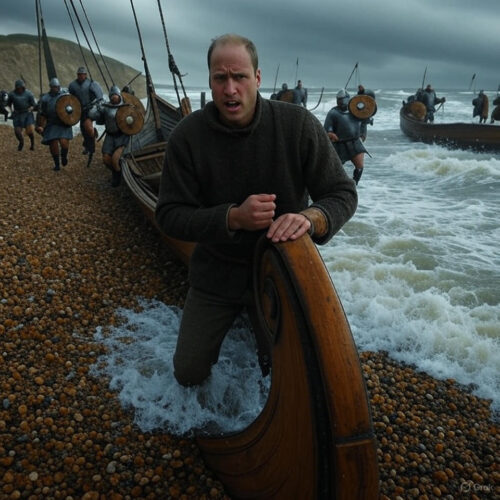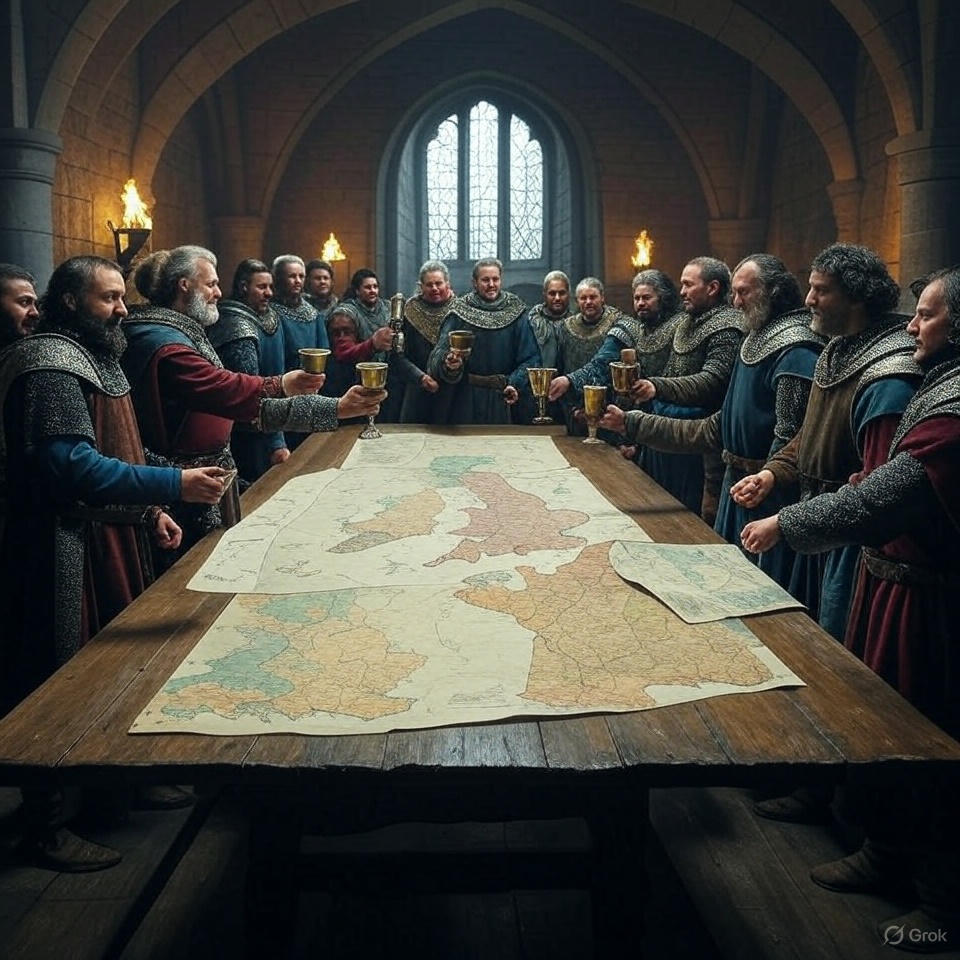Imagine the salt-laced wind whipping across the English Channel, carrying whispers of ambition and the creak of oaken hulls straining against the waves. It’s September 28, 1066—a date etched into the annals of time not with fanfare or thunderous decrees, but with the quiet, resolute splash of boots on pebbled sand. On that fateful autumn day, William, Duke of Normandy, stepped onto the shores of Pevensey Bay in Sussex, England, his fleet of some 700 vessels disgorging an army poised to rewrite the fate of a kingdom. This wasn’t merely an invasion; it was the spark of the Norman Conquest, a cascade of events that would topple kings, reshape languages, and forge the bedrock of what we now call England. But beyond the clash of steel and the roar of conquest lies a deeper tale—one of audacious preparation, unyielding resolve, and the transformative power of seizing the moment when the winds finally turn in your favor.
To truly grasp the magnitude of this landing, we must voyage back through the turbulent currents of 11th-century Europe. William’s story begins not on that Sussex beach, but in the shadowed halls of Normandy, a duchy forged from Viking blood and Frankish cunning. Born around 1028 as William the Bastard—yes, the moniker was as blunt as a broadsword, a testament to his illegitimate birth to Duke Robert I and the tanner’s daughter Herleva—William inherited the ducal throne at the tender age of seven or eight. His early years were a maelstrom of betrayal and bloodshed. Rival nobles, eyeing the child duke’s vulnerability, ignited the “War of the Succession,” a decade-long frenzy of assassinations and skirmishes that left Normandy a patchwork of loyalties tested by fire.
By his twenties, William had clawed his way to stability. The pivotal Battle of Val-ès-Dunes in 1047 saw him, allied with King Henry I of France, crush a rebellion led by his cousin Guy of Burgundy. Picture the scene: muddy fields near Caen churned to slurry under the hooves of Norman destriers, arrows darkening the sky like a plague of iron locusts, and William himself, barely out of boyhood, directing charges that broke the rebel lines. This victory didn’t just secure his duchy; it honed him into a master of logistics and loyalty, skills that would prove indispensable two decades later.
Across the Channel, England simmered under the rule of Edward the Confessor, a king more monk than monarch, whose childless reign brewed a perfect storm of succession intrigue. Edward, exiled in Normandy during the Danish conquests, owed his throne to the powerful Godwinson family. But whispers persisted: had he promised the crown to his distant kinsman William? Norman chroniclers, ever eager to justify their duke’s ambitions, would later swear it so, citing a 1051 visit where Edward allegedly named William heir. Harold Godwinson, the earl of Wessex and de facto ruler, dismissed such tales, but fate conspired otherwise.
In January 1066, Edward died, his final moments shrouded in legend—some say he nominated Harold on his deathbed, others that divine visions foretold doom. The Witenagemot, England’s council of nobles, swiftly elected Harold king, crowning him on January 6 in Westminster Abbey amid a flurry of Saxon cheers. Yet claims swirled like Channel fog. Harald Hardrada, the thunderous king of Norway, invoked a treaty from 1035, demanding the throne for himself. And William? He dispatched an embassy to Harold, demanding fealty and the hand of his daughter in marriage. Harold’s refusal—polite but ironclad—ignited the fuse.
William’s preparations were a symphony of calculated audacity. From early spring, summons flew across Normandy, Flanders, Brittany, and even Aquitaine, calling knights, archers, and foot soldiers to the port of Dives-sur-Mer. By August, his host numbered 7,000 to 12,000 strong—a polyglot force of Normans hardened by feudal wars, Bretons famed for their light cavalry, and Flemings whose crossbows could punch through mail at a hundred paces. Horses, those noble engines of medieval warfare, were stabled aboard specially designed transports, their manes braided against the spray. Provisions piled high: salted pork, hard cheese, barrels of ale, and wheaten biscuits baked to endure the siege of stomachs.
But the Channel, that treacherous moat of Neptune’s wrath, mocked their haste. From mid-August, gales howled, pinning the fleet at Dives. William relocated to Saint-Valery-sur-Somme, closer to England by 150 miles, where the Somme’s estuary offered shelter. Morale frayed; desertions nibbled at the edges. Harold, ever vigilant, mustered the fyrd—England’s levies of freemen—and a fleet of 700 ships along the south coast, from Hastings to Sandwich. For months, they patrolled, eyes fixed on the horizon. But harvest called, and on September 8, with winds still adverse, Harold disbanded his forces, scattering them to reap the golden fields.
Fate’s dice rolled north first. Hardrada struck on September 8, his 300 longships beaching near Riccall, disgorging 15,000 Vikings who sacked Scarborough and routed the northern earls at Fulford on September 20. Harold Godwinson, informed by frantic riders, performed a feat of endurance unmatched in annals: marching 185 miles from London to York in four days, averaging 46 miles daily over rutted Roman roads and boggy fens. On September 25, at Stamford Bridge, his housecarls—elite axemen in lamellar armor—shattered the Norse shield wall. Hardrada fell, pierced by an arrow; Tostig, Harold’s traitorous brother, joined him in Valhalla. Only 24 Norse ships limped home, their dragon prows bloodied.
Exhaustion gripped Harold’s army, many barefoot and shieldless from the forced march. Messengers galloped south: William sails! On the 27th, as dusk bruised the sky over Saint-Valery, a priest processed with the ducal banner—a gonfalon of red dragon on gold, said to be a papal gift legitimizing the venture. Winds veered; stars wheeled. At dawn on the 28th, the fleet—696 ships by the monk Orderic Vitalis’s count—cast off in orderly columns, rowers chanting to drown the sea’s murmur.
The crossing unfolded like a tapestry of peril and precision. William’s vessel, the Mora, led the van, gilded prow slicing foam, its mast flying the papal banner to ward off storms (or so the propagandists claimed). A lantern burned through the night, guiding stragglers. By midday, spotters sighted the low cliffs of Sussex, that emerald fringe scarred by ancient forts. Pevensey Bay, a Roman castrum called Anderitum, yawned invitingly—sheltered, strategic, midway between London and the Kentish ports. As keels grated on shingle, Norman boots hit wet sand. No Saxons awaited; Harold’s fyrd was leagues away, licking wounds in Yorkshire.
William, ever the tactician, wasted no breath on triumph. Foragers fanned out, requisitioning grain from Anderitum’s hinterlands, while carpenters unpacked prefabricated motte-and-bailey castles—oak frames lashed with leather, ready to rise like mechanical beasts. By evening, a wooden redoubt crowned the old Roman walls, its palisades bristling with sentries. Hastings, eight miles east, fell next; another castle sprouted, its ditches dug by Flemish spades. Raids probed deeper, burning crofts to deny Harold supplies and bait him into rash pursuit. William’s knights, mail-clad and spurred, harried the Weald’s hamlets, their war cries echoing: “Dieu aide!”—God aids us.
Word raced to Harold like wildfire on heather. From York, he pivoted south, commandeering carts and horses, his thegns murmuring of omens: a comet (Halley’s, blazing since August) foretold upheaval. In London, he rallied what fyrds he could—perhaps 7,000 souls, a mosaic of yeomen with spears and slings, buttressed by 3,000 housecarls gripping Dane axes that could cleave helmets like eggshells. The march devoured 50 miles in two days, arriving at Caldbec Hill on October 13, just as William’s scouts spied their banners.
The Battle of Hastings dawned October 14, fog lifting to reveal Senlac Hill’s gentle slope, where Harold planted his gonfalon—a golden dragon fighting wyvern. William’s array shimmered: center infantry, flanks cavalry, rear archers loosing parabolic death. The English shield wall held like a living rampart, but William’s feints—cavalry retreats luring Saxons downhill—fractured it. By dusk, as the sun dipped blood-red, Harold fell, cleft by sword or shaft (the Bayeux Tapestry’s arrow-eyed king a staple of romance). His brothers Gyrth and Leofwine lay slain; the English host dissolved into the twilight.
Victory’s afterglow was fleeting. William paused at Hastings, expecting envoys with oaths. Instead, rebellion flared. Edgar the Ætheling, a boy-king of Wessex blood, was proclaimed in London; northern earls Edwin and Morcar girded for war. William scorched Dover’s gates, besieged Romney, but Kent submitted grudgingly. Crossing the Thames at Wallingford—ferrymen poling under truce—he circled London via the Chilterns, razing villages to ash. Dover Castle yielded after a three-day barrage from siege engines hurling stones like vengeful gods. Archbishop Stigand and the earls bent knee at Berkhamsted; London opened its gates.
On Christmas Day 1066, in Westminster’s new abbey—its stones still smelling of mortar—William received the crown from Archbishop Ealdred. Acclamations rang; but panic mistook them for riot, and Normans torched the surrounding warren. Flames lit the new king’s coronation, a pyric omen of the strife to come.
The conquest’s tendrils spread like ivy on ruins. Rebellions simmered: the 1067 uprising in Exeter, where Gypsy-queen-like Gytha led a siege; the 1068 harrying of the north, where William’s “blitz” starved thousands, fields sown with salt. By 1071, he’d crushed Eadric the Wild in the Welsh marches and routed the last Norse fleet at York. Castles mushroomed—over 80 by 1086—grim wardens of Norman will, from the White Tower’s flinty rise in London to motte mounds dotting the Marches.
The Domesday Book, that exhaustive ledger commissioned in 1085, surveyed the realm like a taxman’s ghost: every hide, villein, and plow-team inscribed in Latin script. It revealed a land transfigured—only 5% of southern holdings in English hands, the rest doled to 180 Norman barons. Earldoms, once Saxon sinecures, became Norman fiefs; bishoprics swapped tonsured heads for French-speaking prelates.
Linguistically, the quake reshaped English’s bones. Old English, with its Germanic growl, mingled with Norman French’s lilting vowels. Words like “beef” (from boeuf, the Norman term for the beast on the lord’s table) and “pork” (porc) entered the lexicon, while “cow” and “pig” lingered for the peasant’s toil. Law evolved too: trial by combat supplanted ordeal, feudal oaths bound knights in pyramidic loyalty. The Magna Carta’s seeds sprouted here, in the tension between king and vassal.
Yet amid the upheaval, curiosities abound. William imported masons from Caen, birthing Romanesque arches that vaulted Canterbury’s nave. He hunted deer with ferocity, his Great Cursus in the New Forest displacing villages—folk tales whisper of ghostly processions still. His queen, Matilda of Flanders, diminutive yet iron-willed, endowed abbeys and stitched the Bayeux Tapestry, that 230-foot embroidery chronicling the conquest in woolen vignettes: Halley’s comet as fiery portent, Harold’s oath on saintly relics, the fatal arrow’s arc.
William’s death in 1087, gut-spilled on Rouen’s altar after a riding mishap in Normandy, marked the conquest’s uneasy fruition. His sons—Robert Curthose the feckless, William Rufus the red-tempered, Henry Beauclerc the scholar-king—inherited a realm forever altered. England, once an island of Anglo-Saxon thegndom, became a continental bridge, its culture a hybrid bloom.
Diving deeper into the voyage’s minutiae reveals William’s genius for the granular. Each ship carried a complement calibrated for chaos: 40 rowers, 20 warriors, mounts slung in slings to prevent panic. The Mora, a gift from Matilda’s brother-in-law, boasted a stern castle for command, its sails dyed papal scarlet. Chronicler William of Poitiers recounts how the duke, sleepless, paced decks slick with bilge, consulting horoscopes cast by Breton seers. As land neared, trumpets blared; archers loosed volleys skyward in salute, arrows whistling like liberated souls.
Pevensey’s Roman ghosts lingered. The old Saxon burh, rebuilt by Alfred against Danes, offered ready ramparts—flint walls 20 feet high, gates barred with iron. Normans swarmed in, dismantling Saxon huts for timber, their axes ringing like forge bells. By nightfall, the motte rose: a 50-foot earthen knoll, hauled by wain-loads of soil, topped with a donjon of squared logs. Sentries lit beacon fires, their smoke coiling like serpents to signal kin across the bay.
The raids that followed were surgical strikes of terror. Detachments under Robert, son of the count of Eu, torched Bulverhythe’s thatch, driving peasants inland with pitchforks and cries. Supplies wagons groaned under pilfered hay, mead, and oxen—vital for an army chewing through 10 tons of fodder daily. William, clad in nasal helm and hauberk, rode among them, quelling disputes with a baron’s glare. One tale, from the Carmen de Hastingae Proelio, paints him knighting a commoner mid-raid for slaying a Saxon scout, blood still hot on the blade.
Harold’s counter-march was a saga of Saxon grit. From Stamford Bridge’s corpse-strewn meadows, survivors—perhaps 5,000—wept for thegns felled by Viking bills. Harold, his mail scorched from close-quarters fury, rallied them with oaths to the Golden Dragon. In London, the Thing-stead buzzed: aldermen pledged ox-teams, smiths hammered spearheads anew. The road south twisted through the Weald’s oak groves, where dew-slick leaves muffled hoofbeats. Harold’s vanguard clashed with Norman foragers near Crowhurst, a skirmish of screams and splintered lances that bloodied both sides but yielded no ground.
At Caldbec, omens multiplied. A minstrel sang of Bryhtnoth’s stand at Maldon; priests intoned masses for the morrow. William, too, sought divine favor, his chaplains sprinkling holy water on stirrups. Dawn broke with mist veiling Senlac’s furze, Harold’s men knee-deep in dew, shields overlapping like fish scales. The Norman assault opened with a hail of bodkins—short arrows fletched for accuracy—pinging off limewood bosses. Then came the knights: Odo of Bayeux, William’s half-brother, swinging a mace that crushed helms like walnuts; Eustace of Boulogne charging with Flemish fury.
The feigned retreats were masterstrokes of deception. A Breton wing buckled, luring housecarls downhill in pursuit; hooves thundered back, trampling the unwary. By noon, the wall thinned; axes dulled on anvil-hard shields. William, unhorsed twice, remounted with cries of “I am the duke!”—his voice a beacon amid melee. As light waned, the English right crumbled; Gyrth fell to a lance through the gorget, Leofwine to a sword-thrust. Harold, propped on his Dragon, took the shaft—or blade—to the visage, his cry lost in the din. The Saxons fled to the hill’s crest, cut down in droves; nightfall claimed the field, 3,000 English dead to Normans’ half that.
Post-Hastings, William’s advance was a chess master’s gambit. Hastings Castle became his fulcrum, its hall echoing with feasts of roast boar and minstrel lays. Envoys from Dover parleyed surrender, but resistance flared—Gytha, Harold’s mother, offered her weight in gold for her son’s body, only for William to refuse, burying him unceremoniously at Waltham Abbey. The march on London veered tactical: ferrying at Wallingford spared the bridge’s choke, while flames at Southwark softened the capital’s resolve. Berkhamsted’s submission was sealed with hostages—noble sons as living pledges—and oaths sworn on crossed swords.
Coronation day glittered with peril. Westminster’s choir swelled with “Vivat Rex!” but echoes twisted to alarm; Norman guards, torch in hand, fired the jewelers’ row. William, robed in Byzantine silk, quailed as smoke choked the nave—his first royal act nearly his last. Yet he endured, the crown’s weight a harbinger of heavier burdens.
Rebellions punctuated the next years like thorns on a rose stem. In 1067, Exeter’s walls withstood two months, its defenders hailing arrows from battlements while women hurled stones from the roofs. William starved them out, executing 19 ringleaders but pardoning the rest—a carrot to the stick. The 1068 Welsh foray saw Eadric the Wild, that greenwood lord of Powys, ambush a column, slaying 300 before melting into mires. Northumbria’s harrying in 1069-70 was apocalypse: scorched earth from York to Durham, 100,000 souls famine-felled, rivers choked with corpses. Chronicler Orderic likened it to Judea’s woes, William’s penance a lifelong scourge of conscience.
Castles proliferated as power’s punctuation. The Tower of London, started in 1078, rose from Gundulf’s designs—whitewashed keep piercing the sky, its dungeons echoing with chained dissenters. In the Marches, Clifford and Wigmore squatted like stone wolves, deterring Welsh cattle-raids. Each motte, 30-100 feet high, was a microcosm of feudal might: bailey for stables, chapel for masses, hall for judgments.
The Domesday inquest, launched Christmas 1085, was bureaucratic blitzkrieg. Commissioners—royal justices like Remigius of Lincoln—fanned out, grilling juries on hidages, sokelands, and bordars’ burdens. Scribes, quills scratching vellum, tallied 13.5 million acres, from Kent’s orchards to Cornwall’s tin mines. It wasn’t mere census; it was conquest codified, revealing a land where Norman lords held 90% of the wealth, their demesnes ringed by villein toils.
Culturally, the fusion fizzed. Norman masons arched Durham’s nave in ribbed vaults, precursors to Gothic grace. The Bayeux Tapestry, Matilda’s commission or not, unfurls 70 scenes: Edward’s court in stiff robes, Harold’s shipwreck on Ponthieu’s sands (where Guy captured him, extracting that fateful oath on Bayeux’s relics), the comet’s tail like God’s finger. French infused English—courtly terms like “justice,” “parliament,” “assembly” from Anglo-Norman lips. Even cuisine shifted: Norman pies of pigeon and verjuice supplanted Saxon stews.
William’s personal quirks humanize the colossus. A glutton for venison, he enclosed the New Forest, displacing 30 parishes—folk cursed his soul for it. Childless with paramours, he doted on his legitimate brood, marrying them to Iberian royalty. His piety waxed late: endowments to Fécamp Abbey, pilgrimages to Bec. Yet ruthlessness defined him; the 1075 Revolt of the Earls—Ralph de Gael’s Breton plot—saw Waltheof, last English earl, beheaded at Winchester, his head on a pole for Winchester’s gates.
By 1086, the conquest congealed. Scotland’s Malcolm Canmore paid homage at Salisbury’s plain, 10,000 knights kneeling in fealty’s theater. Ireland’s kings sent tribute; the Welsh chieftains quailed. William’s realm stretched from Orkney’s mists to the Pyrenees’ snows—a trans-Channel empire, fragile as spun glass.
His end came ignominious: besieging Mantes in 1087, a saddle jolt ruptured his girth, spilling entrails amid the rubble. Rouen buried him sans pomp, his corpse bloating as nobles squabbled over spoils. Robert claimed Normandy; Rufus, England; Henry, the coffers. The bastard’s legacy? A nation reborn in fire.

Yet from this forge of history emerges not just chronicles, but catalysts for the soul. The Norman Conquest’s outcome—a radical reinvention through bold incursion—mirrors the pivots we face today. William’s landing teaches that true transformation demands crossing tempests, fortifying first footholds, and pressing advantages with relentless adaptation. In your life, this manifests as embracing disruption to build enduring legacies, turning potential defeats into dynasties of purpose.
To harness this, consider these specific applications:
– **Cultivate Unwavering Preparation Amid Storms**: Just as William amassed allies and vessels despite gales, stockpile skills during calm—master a new language or tool quarterly, ensuring you’re voyage-ready when opportunity’s wind shifts.
– **Seize the Precise Moment of Transition**: Harold’s dispersal of forces post-harvest doomed him; mirror William by timing bold moves—launch that side project immediately after a career milestone, capitalizing on the vacuum left by rivals’ distractions.
– **Fortify Your Foothold with Swift Action**: The Pevensey castle rose overnight; post any “landing” (job switch, relationship start), erect boundaries—schedule weekly reviews to secure gains against early sabotage.
– **Raid Resources Strategically, Not Destructively**: William’s forays sustained without total ruin; in personal growth, “raid” networks ethically—attend one industry event monthly, extracting insights while nurturing reciprocity.
– **Endure the Melee with Tactical Retreats**: Hastings’ feints won the day; in conflicts, practice strategic pauses—after arguments, journal three concessions to de-escalate, turning defense into counteroffensive.
– **Document Your Domain for Lasting Control**: The Domesday Book mapped power; track your “holdings”—monthly ledger of finances, habits, and networks—to redistribute energies toward high-yield pursuits.
– **Fuse Traditions for Hybrid Strength**: Norman-English blend birthed resilience; integrate old comforts with new challenges—blend ancestral recipes with modern fitness, forging a personal culture that’s battle-tested.
**A 30-Day Conquest Plan: Your Personal Norman Landing**
**Week 1: Assemble the Fleet (Preparation Phase)**
– Days 1-3: Audit your current “duchy”—list three ambitions (e.g., career pivot, skill mastery) and five resources (mentors, courses) to muster.
– Days 4-7: Cross the “Channel”—enroll in one online course, network with two contacts, visualizing the adverse winds as temporary.
**Week 2: Make Landfall (Action Phase)**
– Days 8-10: Erect your motte—set one non-negotiable boundary (e.g., no-work evenings) and execute a micro-raid (research one opportunity).
– Days 11-14: March on Hastings—initiate the bold move, tracking daily micro-wins in a journal.
**Week 3: Battle and Adapt (Execution Phase)**
– Days 15-17: Face the shield wall—identify obstacles, practice one feint (e.g., delegate a task to free bandwidth).
– Days 18-21: Press the advantage—review progress, adjust tactics, celebrate a skirmish victory with a ritual (walk in nature).
**Week 4: Crown Your Conquest (Consolidation Phase)**
– Days 22-24: Survey the realm—compile a “Domesday” snapshot of gains, redistributing efforts.
– Days 25-28: Fuse and endure—integrate one new habit from the old self, plan the next voyage.
– Days 29-30: Reflect and reign—write a “coronation oath” vowing sustained momentum, sharing one lesson with a peer.
This plan, rooted in William’s playbook, transforms abstract history into actionable ascent. The duke’s defiance didn’t just conquer a kingdom; it conquered complacency.

The conquest’s echoes reverberate in subtler veins. Consider the ecclesiastical shifts: Norman bishops like Lanfranc of Bec reformed monasteries, enforcing Cluniac discipline—monks rising at matins, copying codices by whale-oil lamps. This rigor birthed scholasticism’s seeds, influencing Abelard’s logic and Aquinas’s sums. In law, the oath’s evolution—from Harold’s coerced swear on St. Relics to Magna Carta’s baronial bulwarks—underpinned habeas corpus, that bulwark against tyranny.
Economically, Domesday discloses a realm in flux: royal demesnes ballooned to 1,400 hides, funding William’s wars. Trade burgeoned—wool from East Anglia shipped to Flemish looms, wine from Gascony quaffed in London halls. The 1086 Salisbury oath, 10,000 knights swearing fealty on one plain, was feudalism’s grand opera, binding land to service in perpetuity.
William’s family saga adds pathos. Matilda, scarce five feet, wielded influence from the shadows—her 1083 pilgrimage to Rome a diplomatic masterstroke. Sons’ rivalries foreshadowed anarchy: Rufus’s hunting “accidents,” Henry’s usurpation of the White Ship’s drowned heirs. Yet from this, Angevin England arose, Henry II’s assizes codifying justice.
Archaeology unearths the grit: excavations at Pevensey yield Norman arrowheads, Saxon stirrups fused in hearth-ash. Bayeux’s linen, stitched by Alençon nuns, fades but endures, its border beasts—fables of Reynard the fox—mocking human folly.
In literature, the conquest birthed Geoffrey of Monmouth’s Arthurian dreams, blending Celtic mists with Norman sheen. Layamon’s Brut, in Middle English’s dawn, versified the landing: “Willelm com mid his monnen stronge.” Even cuisine: the Conqueror’s taste for mustard-spiced lampreys influenced royal tables, a flavor persisting in coronation banquets.
The Viking undercurrents fascinate. William’s Norse blood—from Rollo’s Seine raids—made him kin to Hardrada, foes in fratricidal irony. His knights’ sagas, sung in skaldic fragments, hailed Hastings as “the day the raven won the eagle.”
By 1100, the hybrid hardened. Intermarriages blurred lines—Robert of Rhuddlan wedding Welsh nobility, their heirs bilingual in hall and hunt. The 1088 rebellion, Ralph de Waard’s East Anglian revolt, fused Anglo-Norman malcontents, crushed at Hottesdean by royal levies.
William’s physique, once Herculean, ballooned in later years—his 1087 obit notes a girth that split the bier. Yet his mind sharpened: charters to Saint-Denis, edicts on forest law, preserving game with draconian fines.
The conquest’s demographic scar: 200,000 Normans amid 2 million Saxons, a drop diluting to fusion. Emigrants to Byzantium carried English axes to Constantinople’s walls, Varangians till 1204.
In sum, September 28, 1066, wasn’t a mere footnote; it was history’s hinge, swinging England from insular saga to imperial epic. William’s bootprint on Pevensey sand stamped a legacy of reinvention, reminding us that from defiant shores, worlds are won.


